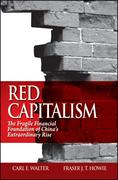
Red capitalism: the fragile financial foundation of China's extraordinary rise
Walter, Carl
Howie, Fraser
In 1974 China’s last Emperor, Deng Xiaoping, traveled to New York to speak atthe United Nations. This was the first time such a senior Chinese leader had ever visited the United States. As the delegation prepared its trip the question was asked, “How can we pay?”A mad scramble ensued in the capital as the Emperor’s men called all the banks to assemble foreign currency. After searching high and low, they were able to scrape up only $38,000. Now just 30 years later China appears to have won the global Monopoly game with foreign exchange reserves of over $2 trillion and an economy the government says will grow at 8% despite recession of the world’s other economies. Everyone is looking to China.How did China in just 30 years pick itself off the floor and become America’slargest creditor, positioning itself if not to surpass the United States, then perhaps acquire major aspects of its crumbling economy? In Red Capitalism authors Carl Walter and Fraser Howie go deep into the Chinese financial machine to illuminate the social and political consequences of China’s unique business model and pose the question whether it has, in fact, lived up to all the hype surrounding it and whether, after all, the 21st century really will be China’s century. Red Capitalism is indispensable reading for those who would understand the limits that China’s past development decisions have imposed on its brilliant future. No one who is considering China business strategies in today’sextremely challenged global economy can afford to miss this book INDICE: Chapter 1: One short nap took me all the way back to before 1949. 1978-2008: 30 years of Opening 1992-2005: 13 years of Reform 2005: the end of Reform China is a family business Chapter 2: Chinas fortress banking system Banks are Chinas financial system Crisis and bank reform, 1994 and 1998Chinas fortress banking system in 2009The sudden thirst for capital and cash dividends,2010 Chapter 3: The fragile fortress The foundation of Chinas banking machineBad bank performance and its implications, 2009The perpetual put option to PBOCChinas new post-Lehman Brothers banking modelImplications Chapter 4: Chinas captive bond market Why does China have a bond market? Yield curves in ChinaThe base of the Pyramid: protecting household depositors Chapter 5: The struggleover Chinas bond markets China Development Bank, the Ministry of Finance and the Big 4 BanksPeoples Bank of China, NDRC and CSRC: corporate bondsLocal governments unleashed China Investment Corporation: the lynchpin of Chinas financial system Cycles in Chinas financial markets Chapter 6: Western finance, SOE reform and Chinas stock markets Why does China have stock markets? What the stock markets gave China Chapter 7: The National Team is Chinas government The National Team, the Organization Department, Huijin and SASAC Chinese stock markets: Who benefits? A casino or a success or both?Implications Chapter 8: The Forbidden City The Emperor of Finance Behind the vermillion walls Red capitalismmeans leverage The Emperors new financial playthings Appendices
- ISBN: 978-0-470-82586-0
- Editorial: John Wiley & Sons
- Encuadernacion: Cartoné
- Páginas: 250
- Fecha Publicación: 23/12/2010
- Nº Volúmenes: 1
- Idioma: Inglés
